Auto Paint Repair Estimates can vary widely, but understanding the types of damage and available repair options is key to getting the best value; AUTO-REPAIR-TRAINING.EDU.VN offers comprehensive resources to help you navigate the complexities of auto paint repair and make informed decisions. Whether you’re dealing with minor scratches or extensive damage, understanding the factors influencing auto paint repair costs, such as ASE certification, business plans, and step-by-step guides, is essential.
Contents
- 1. Understanding Auto Paint Damage Types
- 1.1. Paint Chips: Assessing Size and Extent
- 1.2. Scratches: Evaluating Depth and Length
- 1.3. Scrapes: Determining Surface Impact
- 1.4. Dents with Paint Damage: Addressing the Underlying Issue
- 2. Factors Influencing Auto Paint Repair Estimates
- 2.1. Type and Extent of Damage
- 2.2. Repair Method
- 2.3. Location of the Repair Shop
- 2.4. Type of Paint
- 2.5. Labor Costs
- 3. Decoding Auto Paint Repair Estimates: What to Expect
- 3.1. Understanding Estimate Components
- 3.2. Obtaining Multiple Estimates
- 3.3. Evaluating Estimate Accuracy
- 3.4. Hidden Costs and Fees
- 4. DIY vs. Professional Auto Paint Repair
- 4.1. DIY Auto Paint Repair: Pros and Cons
- 4.2. Professional Auto Paint Repair: Pros and Cons
- 4.3. When to Choose DIY vs. Professional Repair
- 5. Step-by-Step Guide to Obtaining Auto Paint Repair Estimates
- 5.1. Assessing the Damage
- 5.2. Researching Local Repair Shops
- 5.3. Contacting Repair Shops
- 5.4. Scheduling Estimates
- 5.5. Reviewing Estimates
- 5.6. Choosing a Repair Shop
- 5.7. Scheduling the Repair
- 5.8. Inspecting the Repair
- 6. Cost-Saving Tips for Auto Paint Repair
- 6.1. Addressing Damage Promptly
- 6.2. Opting for Touch-Up Repairs
- 6.3. Considering Mobile Repair Services
- 6.4. Negotiating Prices
- 6.5. Choosing Generic Parts
- 6.6. Maintaining Your Vehicle’s Paint
- 7. Career Paths in Auto Paint Repair
- 7.1. Becoming an Auto Body Technician
- 7.2. Pursuing ASE Certification
- 7.3. Starting Your Own Auto Paint Repair Business
- 7.4. Skills and Training Needed
- 7.5. Educational Resources
- 8. Insurance Coverage for Auto Paint Repair
- 8.1. Comprehensive Coverage
- 8.2. Collision Coverage
- 8.3. Deductibles
- 8.4. Filing an Insurance Claim
- 8.5. Working with Insurance Adjusters
- 8.6. When to File a Claim
- 9. Opening Your Own Auto Paint Repair Shop: A Business Plan
- 9.1. Market Analysis
- 9.2. Services Offered
- 9.3. Business Structure
- 9.4. Funding Sources
- 9.5. Location and Equipment
- 9.6. Marketing Strategy
- 9.7. Management Team
- 9.8. Financial Projections
- 9.9. Business Licenses and Permits
- 9.10. Grand Opening
- 10. Auto Paint Repair FAQs
- 10.1. How Can I Find A Reputable Auto Paint Repair Shop?
- 10.2. How Much Does A Typical Auto Paint Repair Cost?
- 10.3. What Are The Different Types Of Auto Paint?
- 10.4. Can I Repair Auto Paint Damage Myself?
- 10.5. How Long Does Auto Paint Repair Typically Take?
- 10.6. What Is Paintless Dent Repair?
- 10.7. Will Auto Paint Repair Affect My Vehicle’s Value?
- 10.8. What Is Color Matching?
- 10.9. How Can I Protect My Vehicle’s Paint?
- 10.10. How Can AUTO-REPAIR-TRAINING.EDU.VN Help Me With Auto Paint Repair?
1. Understanding Auto Paint Damage Types
Before diving into auto paint repair estimates, it’s crucial to accurately assess the type and severity of the damage to your vehicle’s paint. Different types of damage require different repair techniques, which significantly impact the overall cost.
1.1. Paint Chips: Assessing Size and Extent
Paint chips are a common issue, often resulting from road debris or minor impacts. The cost to repair paint chips largely depends on their size and how widespread they are.
- Minor Paint Chips: These are typically small, about the size of a pencil eraser or smaller. Repairing minor paint chips is usually less expensive and can often be addressed with touch-up paint or mobile repair services.
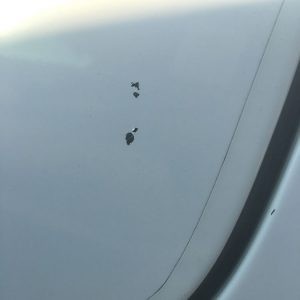 Minor Car Paint Chips
Minor Car Paint Chips - Extensive Paint Chips: Larger chips, especially those with cracking or peeling paint around them, require more extensive repair. This might involve filling the chip, sanding, and repainting the area, leading to higher auto paint repair estimates.
 Extensive Peeling
Extensive Peeling
1.2. Scratches: Evaluating Depth and Length
Scratches are another frequent type of paint damage. The depth and length of the scratch determine the complexity and cost of the repair.
- Minor Scratches: These are superficial scratches that only affect the clear coat layer. They often disappear temporarily when wet. Minor scratches are generally easy to fix with polishing compounds and can be a relatively inexpensive repair.
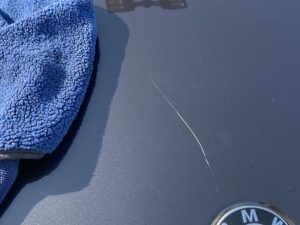 Minor Scratch
Minor Scratch - Extensive Scratches: Deeper scratches that penetrate the clear coat and reach the paint or even the metal require more intensive work. These scratches, or any scratch longer than six inches, might need sanding, filling, and repainting, significantly increasing the auto paint repair estimates.
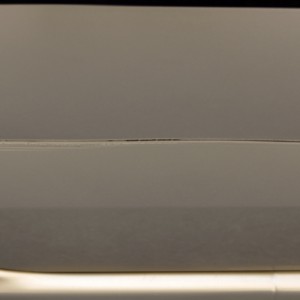 Extensive Scratch
Extensive Scratch
1.3. Scrapes: Determining Surface Impact
Scrapes occur when the vehicle’s paint rubs against another object, such as a wall or another car. The severity of the scrape affects the repair method and cost.
- Minor Scrapes: These are surface-level scrapes that don’t expose the metal and are confined to a small area. Sometimes, these scrapes are just a transfer of material and can be removed with rubbing compound.
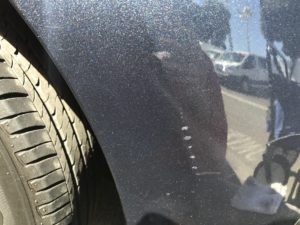 Minor Scrape
Minor Scrape - Extensive Scrapes: Scrapes that have significantly damaged the surface, cover a large area, or have removed the paint entirely are considered extensive. Repairing these scrapes involves bodywork, priming, and repainting, leading to higher auto paint repair estimates.
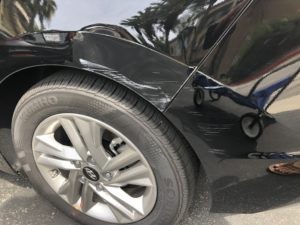 Extensive Scrape
Extensive Scrape
1.4. Dents with Paint Damage: Addressing the Underlying Issue
When paint damage is accompanied by a dent, it’s essential to address the dent first. Repairing the dent ensures that the paint job isn’t compromised by further bodywork.
- Minor Dents: Dents on flat surfaces are typically easier and less expensive to repair.
- Extensive Dents: Dents on curved surfaces or those that have severely misshapen the metal require more specialized skills and can be more costly to repair. In some cases, severely damaged panels may need to be replaced entirely.
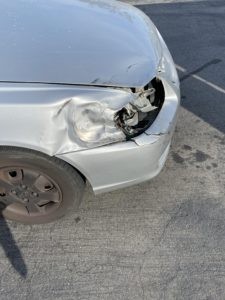 Extensive Dent
Extensive Dent
2. Factors Influencing Auto Paint Repair Estimates
Several key factors influence auto paint repair estimates, including the type and extent of the damage, the repair method, the location of the repair shop, and the type of paint used. Understanding these factors can help you make informed decisions and potentially lower your repair costs.
2.1. Type and Extent of Damage
As discussed earlier, the type and extent of the paint damage are primary determinants of the repair cost. Minor chips and scratches are less expensive to fix than extensive scrapes or dents with paint damage.
2.2. Repair Method
The chosen repair method significantly impacts the cost. Options include touch-up repairs, mobile spray paint services, and traditional body shop repairs.
- Touch-Up Repairs: Ideal for minor damage, touch-up repairs involve applying paint to small chips and scratches. This is the most cost-effective option but may not provide a perfect match to the original paint.
- Mobile Spray Paint Services: For moderate damage, mobile spray paint services can be a good option. Technicians come to your location and spray paint the affected area.
- Body Shop Repairs: For extensive damage or when a perfect finish is desired, a body shop is necessary. Body shops offer professional-grade paint matching and application in a controlled environment.
2.3. Location of the Repair Shop
The location of the auto paint repair shop can also affect the price. Shops in urban areas or high-cost-of-living regions may charge more than those in rural areas.
2.4. Type of Paint
The type of paint used can also influence the cost. Standard paints are less expensive than specialty paints, such as metallic, pearl, or custom colors, which require more expertise to match and apply correctly.
2.5. Labor Costs
Labor costs vary depending on the shop’s hourly rate and the complexity of the repair. More complex repairs require more time and skill, leading to higher labor costs.
3. Decoding Auto Paint Repair Estimates: What to Expect
When obtaining auto paint repair estimates, it’s important to understand what the estimate includes and how to evaluate its accuracy. A comprehensive estimate should break down the costs of parts, labor, and any additional services.
3.1. Understanding Estimate Components
A typical auto paint repair estimate includes the following components:
- Parts: This includes the cost of paint, primer, clear coat, and any other materials needed for the repair.
- Labor: This is the cost of the technician’s time to perform the repair. Labor costs are usually calculated based on an hourly rate.
- Additional Services: This may include costs for dent repair, surface preparation, paint matching, and finishing.
- Taxes: Sales tax on parts and labor.
3.2. Obtaining Multiple Estimates
To ensure you’re getting a fair price, it’s recommended to obtain multiple auto paint repair estimates from different shops. Comparing estimates allows you to assess the range of prices and the services offered.
3.3. Evaluating Estimate Accuracy
When evaluating auto paint repair estimates, consider the following:
- Detail: A detailed estimate is more reliable than a vague one. It should specify the type of work to be done, the materials to be used, and the labor hours required.
- Reputation: Check the shop’s reputation by reading online reviews and asking for referrals. A reputable shop is more likely to provide an accurate and fair estimate.
- Warranty: Ask about the shop’s warranty on paint repairs. A good warranty can protect you against defects in materials or workmanship.
3.4. Hidden Costs and Fees
Be aware of potential hidden costs and fees, such as disposal fees, environmental fees, or charges for paint matching. Ask the shop to explain all charges upfront to avoid surprises.
4. DIY vs. Professional Auto Paint Repair
Deciding whether to tackle auto paint repair yourself or hire a professional depends on your skill level, the extent of the damage, and your budget. While DIY repairs can save money, they may not always provide the best results.
4.1. DIY Auto Paint Repair: Pros and Cons
DIY auto paint repair can be a cost-effective option for minor damage, such as small chips and scratches. However, it requires patience, skill, and the right tools and materials.
- Pros:
- Cost Savings: DIY repairs can save money on labor costs.
- Convenience: You can perform the repair at your own pace and on your own schedule.
- Learning Experience: DIY repairs can be a learning experience for those interested in auto maintenance.
- Cons:
- Skill Required: Achieving a professional-looking finish requires skill and experience.
- Time Commitment: DIY repairs can be time-consuming, especially for those new to the process.
- Potential for Mistakes: Mistakes can be costly and may require professional repair to correct.
- Matching Issues: Matching the paint color perfectly can be difficult, especially with metallic or custom colors.
4.2. Professional Auto Paint Repair: Pros and Cons
Professional auto paint repair offers high-quality results and convenience, but it comes at a higher cost.
- Pros:
- High-Quality Results: Professional technicians have the skills, tools, and materials to achieve a flawless finish.
- Convenience: You can drop off your vehicle and have the repair done while you focus on other tasks.
- Warranty: Professional repairs often come with a warranty, providing peace of mind.
- Accurate Paint Matching: Professionals can accurately match the paint color, ensuring a seamless repair.
- Cons:
- Higher Cost: Professional repairs can be more expensive than DIY repairs.
- Scheduling: You may need to schedule an appointment and wait for the repair to be completed.
4.3. When to Choose DIY vs. Professional Repair
Consider the following factors when deciding between DIY and professional auto paint repair:
- Extent of Damage: DIY repairs are best suited for minor chips and scratches. Extensive damage should be left to professionals.
- Skill Level: If you have experience with auto painting and bodywork, DIY may be a viable option. If not, professional repair is recommended.
- Budget: DIY repairs can save money, but professional repairs may be worth the investment for a high-quality finish.
- Time: DIY repairs can be time-consuming. If you’re short on time, professional repair may be the better choice.
5. Step-by-Step Guide to Obtaining Auto Paint Repair Estimates
Obtaining accurate and fair auto paint repair estimates involves several key steps. Following this guide can help you navigate the process and make informed decisions.
5.1. Assessing the Damage
The first step is to thoroughly assess the damage to your vehicle’s paint. Take photos and notes of the type, size, and location of the damage. This information will be helpful when describing the damage to repair shops.
5.2. Researching Local Repair Shops
Research local auto paint repair shops by reading online reviews, checking their ratings, and asking for referrals from friends and family. Look for shops with a good reputation for quality work and customer service.
5.3. Contacting Repair Shops
Contact several repair shops to inquire about their auto paint repair estimates. Provide them with detailed information about the damage, including photos if possible. Ask about their process for providing estimates and whether they offer free estimates.
5.4. Scheduling Estimates
Schedule in-person estimates with the repair shops. This allows the technicians to inspect the damage firsthand and provide a more accurate estimate.
5.5. Reviewing Estimates
Review the estimates carefully, comparing the costs of parts, labor, and additional services. Look for any discrepancies or hidden fees. Ask the shops to explain any unclear charges.
5.6. Choosing a Repair Shop
Choose a repair shop based on their reputation, the accuracy of their estimate, the quality of their work, and their warranty. Don’t necessarily choose the cheapest option, as quality and reliability are important factors to consider.
5.7. Scheduling the Repair
Once you’ve chosen a repair shop, schedule the repair at a convenient time. Be sure to confirm the estimated completion date and any other important details.
5.8. Inspecting the Repair
After the repair is completed, inspect the work carefully to ensure it meets your expectations. Check for any imperfections in the paint finish and address any concerns with the repair shop.
6. Cost-Saving Tips for Auto Paint Repair
There are several ways to save money on auto paint repair without compromising the quality of the work. Here are some cost-saving tips to consider:
6.1. Addressing Damage Promptly
Addressing paint damage promptly can prevent it from worsening, potentially saving you money on more extensive repairs later on. Small chips and scratches can quickly turn into larger problems if left untreated.
6.2. Opting for Touch-Up Repairs
For minor damage, opt for touch-up repairs instead of more expensive options like mobile spray paint services or body shop repairs. Touch-up repairs are a cost-effective way to address small chips and scratches.
6.3. Considering Mobile Repair Services
Mobile repair services can be a convenient and cost-effective option for moderate damage. They often offer lower prices than traditional body shops.
6.4. Negotiating Prices
Don’t be afraid to negotiate prices with repair shops. Ask if they offer any discounts or promotions. You can also compare estimates from different shops and use them as leverage to negotiate a better price.
6.5. Choosing Generic Parts
If possible, choose generic parts instead of OEM (Original Equipment Manufacturer) parts. Generic parts are often less expensive but can still provide good quality.
6.6. Maintaining Your Vehicle’s Paint
Regularly washing and waxing your vehicle can protect the paint from damage and prevent the need for costly repairs. A well-maintained paint job is less likely to suffer from chips, scratches, and fading.
7. Career Paths in Auto Paint Repair
For those interested in a career in auto paint repair, there are several paths to consider. AUTO-REPAIR-TRAINING.EDU.VN provides resources and training programs to help you pursue your career goals.
7.1. Becoming an Auto Body Technician
An auto body technician specializes in repairing and refinishing vehicle bodies. This career path requires formal training, such as a vocational school program or apprenticeship.
According to the U.S. Bureau of Labor Statistics, the median annual wage for auto body and related repairers was $51,530 in May 2023. The job outlook for this occupation is projected to grow 4 percent from 2022 to 2032, about average for all occupations.
7.2. Pursuing ASE Certification
ASE (Automotive Service Excellence) certification is a widely recognized credential that demonstrates competence in auto repair. Earning ASE certification can enhance your career prospects and earning potential.
7.3. Starting Your Own Auto Paint Repair Business
Starting your own auto paint repair business can be a rewarding entrepreneurial venture. However, it requires careful planning, adequate funding, and strong business management skills.
AUTO-REPAIR-TRAINING.EDU.VN offers resources and guidance to help you develop a business plan, secure funding, and manage your auto paint repair business.
7.4. Skills and Training Needed
To succeed in auto paint repair, you need a combination of technical skills, attention to detail, and customer service skills. Essential skills and training include:
- Auto Body Repair Techniques: Knowledge of dent repair, welding, and panel replacement.
- Paint Refinishing: Expertise in paint mixing, matching, and application.
- Customer Service: Ability to communicate effectively with customers and address their concerns.
- Business Management: Skills in budgeting, marketing, and managing employees.
7.5. Educational Resources
AUTO-REPAIR-TRAINING.EDU.VN offers a range of educational resources to help you develop the skills and knowledge needed for a successful career in auto paint repair. These resources include:
- Online Courses: Flexible online courses covering various aspects of auto paint repair.
- Hands-On Training: Practical training programs that provide hands-on experience in auto body repair and painting.
- Certification Programs: Programs designed to prepare you for ASE certification exams.
- Business Resources: Tools and resources to help you start and manage your own auto paint repair business.
8. Insurance Coverage for Auto Paint Repair
Understanding your insurance coverage for auto paint repair is essential for managing repair costs. The extent of your coverage depends on your insurance policy and the circumstances of the damage.
8.1. Comprehensive Coverage
Comprehensive coverage typically covers auto paint repair resulting from incidents other than collisions, such as vandalism, weather damage, or falling objects. If your vehicle’s paint is damaged in one of these incidents, your comprehensive coverage may pay for the repair, subject to your deductible.
8.2. Collision Coverage
Collision coverage covers auto paint repair resulting from collisions with other vehicles or objects. If your vehicle’s paint is damaged in a collision, your collision coverage may pay for the repair, subject to your deductible.
8.3. Deductibles
A deductible is the amount you must pay out of pocket before your insurance coverage kicks in. Your deductible can significantly impact the overall cost of auto paint repair.
8.4. Filing an Insurance Claim
If you have insurance coverage for auto paint repair, you’ll need to file an insurance claim with your insurance company. Your insurance company will investigate the claim and determine the extent of coverage.
8.5. Working with Insurance Adjusters
Insurance adjusters are responsible for assessing the damage and determining the amount your insurance company will pay for the repair. It’s important to work with the insurance adjuster to ensure you receive a fair settlement.
8.6. When to File a Claim
Consider the following factors when deciding whether to file an insurance claim for auto paint repair:
- Extent of Damage: Filing a claim may be worthwhile for extensive damage, but it may not be necessary for minor chips and scratches.
- Deductible: Compare the cost of the repair to your deductible. If the repair cost is less than your deductible, it may not be worth filing a claim.
- Insurance Rates: Filing a claim may increase your insurance rates. Consider the potential impact on your rates before filing a claim.
9. Opening Your Own Auto Paint Repair Shop: A Business Plan
If you’re considering opening your own auto paint repair shop, developing a comprehensive business plan is essential for success. AUTO-REPAIR-TRAINING.EDU.VN can guide you through each step of the planning process.
9.1. Market Analysis
Conduct thorough market research to identify your target customers, assess the competition, and evaluate the demand for auto paint repair services in your area.
9.2. Services Offered
Determine the range of services you will offer, such as auto body repair, paint refinishing, dent removal, and detailing. Consider specializing in certain areas to differentiate your shop from the competition.
9.3. Business Structure
Choose a legal structure for your business, such as a sole proprietorship, partnership, limited liability company (LLC), or corporation. Consult with an attorney and accountant to determine the best structure for your needs.
9.4. Funding Sources
Identify potential funding sources for your business, such as personal savings, loans from banks or credit unions, or investors. Develop a detailed financial plan to secure funding.
9.5. Location and Equipment
Choose a suitable location for your shop, considering factors such as visibility, accessibility, and zoning regulations. Invest in high-quality equipment, such as paint spray booths, welding machines, and dent removal tools.
9.6. Marketing Strategy
Develop a marketing strategy to attract customers to your shop. This may include online advertising, social media marketing, local partnerships, and promotional offers.
9.7. Management Team
Assemble a skilled and experienced management team to oversee the day-to-day operations of your shop. This may include a shop manager, technicians, and customer service representatives.
9.8. Financial Projections
Develop detailed financial projections, including revenue forecasts, expense budgets, and cash flow statements. This will help you track your financial performance and make informed business decisions.
9.9. Business Licenses and Permits
Obtain all necessary business licenses and permits to operate your auto paint repair shop legally. This may include a business license, auto repair license, and environmental permits.
9.10. Grand Opening
Plan a grand opening event to introduce your shop to the community and attract new customers. Offer special promotions and discounts to celebrate the opening.
10. Auto Paint Repair FAQs
Navigating the world of auto paint repair can be confusing. Here are some frequently asked questions to help you understand the process and make informed decisions.
10.1. How Can I Find A Reputable Auto Paint Repair Shop?
Start by researching online reviews and asking for recommendations from friends and family. Look for shops with ASE certification and a good reputation for quality work and customer service.
10.2. How Much Does A Typical Auto Paint Repair Cost?
The cost of auto paint repair varies depending on the type and extent of the damage, the repair method, and the location of the shop. Minor repairs may cost as little as $150, while more extensive repairs can cost several thousand dollars.
10.3. What Are The Different Types Of Auto Paint?
Common types of auto paint include enamel, lacquer, acrylic, and urethane. Each type of paint has its own advantages and disadvantages in terms of durability, appearance, and cost.
10.4. Can I Repair Auto Paint Damage Myself?
DIY auto paint repair is possible for minor damage, but it requires skill, patience, and the right tools and materials. For extensive damage, professional repair is recommended.
10.5. How Long Does Auto Paint Repair Typically Take?
The duration of auto paint repair depends on the extent of the damage and the repair method. Minor repairs may take a few hours, while more extensive repairs can take several days or even weeks.
10.6. What Is Paintless Dent Repair?
Paintless dent repair (PDR) is a technique for removing dents without damaging the paint finish. PDR is a cost-effective option for minor dents that have not damaged the paint.
10.7. Will Auto Paint Repair Affect My Vehicle’s Value?
Professional auto paint repair can restore your vehicle’s appearance and maintain its value. However, poorly done repairs can negatively impact your vehicle’s value.
10.8. What Is Color Matching?
Color matching is the process of matching the new paint to the existing paint on your vehicle. Accurate color matching is essential for a seamless repair.
10.9. How Can I Protect My Vehicle’s Paint?
Regularly washing and waxing your vehicle can protect the paint from damage and prevent the need for costly repairs. Consider using a paint sealant or ceramic coating for added protection.
10.10. How Can AUTO-REPAIR-TRAINING.EDU.VN Help Me With Auto Paint Repair?
AUTO-REPAIR-TRAINING.EDU.VN offers comprehensive resources and training programs to help you navigate the complexities of auto paint repair, whether you’re looking to hire a professional or pursue a career in the field.
Are you ready to take the next step in your auto paint repair journey? Contact AUTO-REPAIR-TRAINING.EDU.VN today for expert guidance and personalized assistance. Whether you’re seeking training programs or guidance on starting your own auto paint repair business, we’re here to help you succeed. Contact us at 200 N Michigan Ave, Suite 1500, Chicago, IL 60601, United States, or reach out via WhatsApp at +1 (641) 206-8880. Visit our website at AUTO-REPAIR-TRAINING.EDU.VN for more information.
